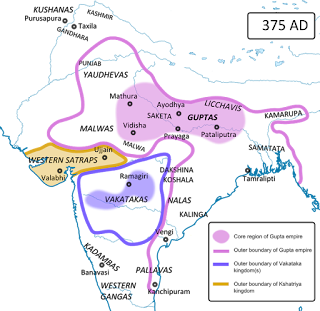Rise of Gupta Empire Navaratnas Kalidasa, Khadakarpara, Kshapanaka, Vararuchi, Vetala Bhatta, Varahamihira, Amarasimha, Shanku, Dhanvantari.
Rise of Gupta Empire

- After the Mauryan empire, many small kingdoms rose and fell. In the period from BC 300 to 700 AD.
- Imperial rule evolved, paving the way for state formation in many regions
- During this period, the Gupta kingdom emerged as a great power and achieved the political unification of a large part of the Indian subcontinent.
- It featured a strong central government, bringing many kingdoms under its hegemony.
- The first ruler of the Gupta Empire was Sri Gupta (240–280 CE) who was succeeded by his son Ghatotkacha (280–319 CE).
- Chandragupta I, the son of Ghatotkacha, ruled from 319 to 335 CE and is considered to be the first great king of the Gupta Empire.
- Chandragupta held the title of maharaja-adhiraja (great king over other kings)
- Chandragupta I appointed his son Samudragupta to succeed him in 335 CE.
- Southern kings paid tribute, while the northern kingdoms were annexed to the Gupta Empire under Samudragupta.
- Chandragupta I is considered to be the founder of the Gupta era which starts with his accession in A.D. 320.
- Samudragupta patronised scholars and poets like Harisena and thus promoted Sanskrit literature.
![[feature] Gupta Empire Gupta Empire](https://blogger.googleusercontent.com/img/b/R29vZ2xl/AVvXsEjmyLrre6XT6Q42NsBut0vI2FVMjM4rQrNokqlB5MQBsi_8CC0WH4uDYjCKlljmNpiHTzGMa4QRjAuTEGV2EARJPSf-0ppRrbEGlRh65k0rB6H1Yt-NrviTuLL6JO6q3nHpjaubGHDTcLCU/s1600/gupta-empire.jpg)
- [message]
- Info Plus
- Samudragupta's attacks mentioned in the 'Prashasti' written by his court poet Harisena. The 'Prashasti' is inscribed on the pillar in Allahabad.
- As a lover of poetry and music, he was given the title “Kaviraja”.
- His coins bear the insignia of him playing the vina (lute).
- Chandragupta II was a capable ruler, who ruled for 40 years from c. 375 to 415 CE.
- He is also known as Vikramaditya
- He transferred the capital from Pataliputra to Ujjain
- His court had nine jewels or navaratnas,
Navaratnas
- Nine eminent people in various fields of art, literature and science.
- This included the great Sanskrit poet Kalidasa, the Sanskrit scholar Harisena, the lexicographer Amarasimha, and the physician Dhanvantari.
- Fahien, the Buddhist scholar from China, visited India during his reign. He records the prosperity of the Gupta Empire.
- Chandragupta II was the first Gupta ruler to issue silver coins.
- [message]
- Navaratnas
- Kalidasa, Khadakarpara, Kshapanaka, Vararuchi, Vetala Bhatta, Varahamihira, Amarasimha, Shanku, Dhanvantari.
Gupta Empire

- Chandragupta II rule thus formed the peak period of Gupta’s territorial expansion.
- Chandragupta II was succeeded by his son Kumara Gupta I, who founded the Nalanda University.
- The last great king of the Gupta dynasty, Skanda Gupta, was the son of Kumara Gupta I.
- The Gupta Empire declined after the death of Skanda Gupta in 467 CE.
- The last recognized king of the Gupta line was Vishnu Gupta who reigned from 540 to 550 CE.
Gupta Period
- A large extent of land was donated to Jain saints, Buddhist monks, Brahmanas and to the officials in the palace.
- They made the farmers work in their land. But the farmers had no right on the land.
- There was an increase in agricultural production whereas the life of the farmers was pathetic.
- The fall of the Roman empire caused for the decline of trade during the Gupta period.
- Power was concentrated on the landlords. The royal power weakened.
- Various kinds of discriminations existed in the society during that time.
- Varna system became rigid. The kings encouraged Vaishnava and Shaiva sects and built many temples.
[post_ads]










COMMENTS